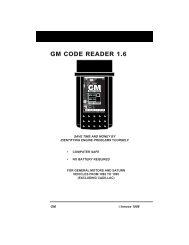Create successful ePaper yourself
Turn your PDF publications into a flip-book with our unique Google optimized e-Paper software.
Onboard Diagnostics<br />
COMPUTER ENGINE CONTROLS<br />
� Powertrain Control Module (PCM) - The PCM is the OBD2<br />
accepted term for the vehicle’s “on-board computer.” In addition<br />
to controlling the engine management and emissions systems,<br />
the PCM also participates in controlling the powertrain<br />
�<br />
(transmission) operation. Most PCMs also have the ability to<br />
communicate with other computers on the vehicle (ABS, ride<br />
control, body, etc.).<br />
Monitor - Monitors are “diagnostic routines” programmed into the<br />
PCM. The PCM utilizes these programs to run diagnostic tests, and<br />
to monitor operation of the vehicle’s emissions-related components<br />
or systems to ensure they are operating correctly and within the<br />
vehicle’s manufacturer specifications. Currently, up to eleven<br />
Monitors are used in OBD2 systems. Additional Monitors will be<br />
added as the OBD2 system is further developed.<br />
Not all vehicles support all eleven Monitors.<br />
� Enabling Criteria - Each Monitor is designed to test and monitor<br />
the operation of a specific part of the vehicle’s emissions system<br />
(EGR system, oxygen sensor, catalytic converter, etc.). A specific<br />
set of “conditions” or “driving procedures” must be met before the<br />
computer can command a Monitor to run tests on its related system.<br />
These “conditions” are known as “Enabling Criteria.” The<br />
requirements and procedures vary for each Monitor. Some Monitors<br />
only require the ignition key to be turned “On” for them to run and<br />
complete their diagnostic testing. Others may require a set of<br />
complex procedures, such as, starting the vehicle when cold,<br />
bringing it to operating temperature, and driving the vehicle under<br />
specific conditions before the Monitor can run and complete its<br />
diagnostic testing.<br />
� Monitor Has/Has Not Run - The terms “Monitor has run” or<br />
“Monitor has not run” are used throughout this manual. “Monitor<br />
has run,” means the PCM has commanded a particular Monitor to<br />
perform the required diagnostic testing on a system to ensure the<br />
system is operating correctly (within factory specifications). The term<br />
“Monitor has not run” means the PCM has not yet commanded a<br />
particular Monitor to perform diagnostic testing on its associated part<br />
of the emissions system.<br />
� Trip - A Trip for a particular Monitor requires that the vehicle is<br />
being driven in such a way that all the required “Enabling Criteria”<br />
for the Monitor to run and complete its diagnostic testing are met.<br />
The “Trip Drive Cycle” for a particular Monitor begins when the<br />
ignition key is turned “On.” It is successfully completed when all the<br />
“Enabling Criteria” for the Monitor to run and complete its diagnostic<br />
testing are met by the time the ignition key is turned “Off.” Since<br />
each of the eleven monitors is designed to run diagnostics and<br />
testing on a different part of the engine or emissions system, the<br />
“Trip Drive Cycle” needed for each individual Monitor to run and<br />
complete varies.<br />
OBD2&1 15




